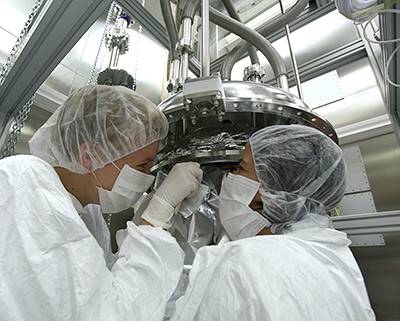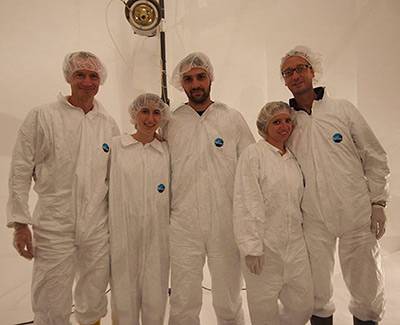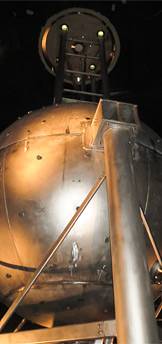In a laboratory under a mountain 80 miles east of Rome this fall, a Princeton-led international team switched on a new experiment aimed at finding a mysterious substance that makes up a quarter of the universe but has never been seen.
The experiment, known as DarkSide-50, is searching for particles of dark matter. For the last several decades, researchers have known that visible matter — the stuff we can see — makes up only 4 percent of the universe, while dark energy is thought to make up about 73 percent. Dark matter is thought to make up the remaining 23 percent, and finding it, researchers say, will solidify our understanding of how the universe formed and shed light on its ultimate fate.
"This is like the search for the Higgs boson was 10 years ago," said Peter Meyers, a professor of physics at Princeton University and one of the lead scientists on the project. "We have a good idea of what to look for, but we don't know exactly where or when we will find it."

The DarkSide-50 research team is made up of faculty, students and researchers from dozens of institutions around the world, including, from left, Luca Grandi, an assistant professor at the University of Chicago, Richard Saldanha, an associate fellow at the University of Chicago, and Hanguo Wang, a researcher at the University of California-Los Angeles. While wearing protective clothing to keep the environment clean, they are working to assemble the core of the dark matter detector, an argon-filled tank with photodetectors at the top and bottom to spot the light from collisions, and copper coils to help determine where the collisions occur. (Photo by Yury Suvorov, University of California-Los Angeles)
Housed inside a cavernous chamber in Italy's Gran Sasso National Laboratory, the DarkSide-50 collaboration involves 17 American institutions as well the Italian Institute for Nuclear Physics and other institutions in Italy, France, Poland, Ukraine, Russia and China, as shown in a list of the participating organizations (.pdf). The research team includes postdocs, staff researchers and several graduate and undergraduate students from Princeton.
The researchers spent last summer assembling the detector, which consists of three fluid-filled chambers nested one inside the other like Russian dolls. Now that the experiment is up and running, the waiting begins. Unlike the massive Large Hadron Collider that discovered the Higgs, DarkSide-50 doesn't smash anything. Instead, it is designed to detect dark matter particles that drift through its chambers.
Looking for WIMPs
The evidence for dark matter dates to the 1930s, when astronomers realized that the amount of matter we can see — as planets, stars and galaxies — falls far short of what must be out there to give galaxies their characteristic spiral shapes and clustering patterns.
Without this missing matter, the galaxies should have flown apart long ago. Matter provides the gravity that keeps the stars in rotation around the galaxy's center. Unless our theories of gravity are wrong — and a minority of physicists think that is a possibility — dark matter must exist.
"Finding dark matter particles would help confirm our understanding of the universe," said Cristiano Galbiati, an associate professor of physics at Princeton. "And, whether or not we find it, we will have learned a great deal about how to go about looking for it. This is as exciting a moment in the search for dark matter as there has ever been."

Princeton senior Maria Okounkova (left) and Kirsten Randle, a junior at the University of Massachusetts-Amherst, prepare equipment for use in the DarkSide-50 detector. They are wearing protective clothing to keep the environment clean. (Photo by Yury Suvorov, University of California-Los Angeles)
Although no one knows for sure what dark matter is made of, the DarkSide-50 team and many other scientists think the most likely candidate is a particle so weak that it is called a WIMP, which is short for "weakly interacting massive particle."
As the name suggests, WIMPs barely interact with their surroundings. They simply drift through walls like ghosts. If you cup your hands together, you will surround — but never trap — a few of these ethereal beings.
Scientists suggest that a WIMP can be detected when it smacks into the nucleus of an atom such as argon, which is found in air. When this happens in a chamber of densely packed argon atoms, the stricken atom recoils and creates a track of excited argon atoms in its wake. This track appears as a fleeting trail of light, which can be detected by devices called photodetectors.
But these collisions are rare — just a few WIMPs are detected each year. Because other particles also give off light when they collide with argon, DarkSide-50 is located nearly a mile beneath Gran Sasso mountain ("gran sasso" is Italian for "great stone"). The rock shields out cosmic-ray particles that routinely bombard the Earth.
"Separating the rare WIMP events from background is the main challenge of all dark matter experiments," said Princeton physics professor Frank Calaprice, who leads the project with Meyers and Galbiati.
"DarkSide is an attempt to build an apparatus that is as close as possible to an ideal 'background-free detector.' The design benefits from methods and two decades of experience that the Princeton group had developing the Borexino solar neutrino experiment," he said, referring to another experiment at Gran Sasso that ultimately achieved record-breaking low backgrounds and the detection of rare solar neutrinos, which are elementary particles that were theorized to exist long before they were detected.
The scientists and students from Princeton and the other institutions have spent hours in this secluded laboratory, which is accessible solely from an exit off a six-mile-long tunnel on a highway that traverses Italy from Rome to the country's east coast. Vehicles approaching the lab are stopped by a large steel door and guard station, prompting comparisons to a supervillain's lair.
The project exemplifies why Princeton is an exceptional place to study as an undergraduate, said senior Will Taylor, who spent a week at the lab in October working on a system for removing trace amounts of radioactive particles from the water used in the detector.
"What makes Princeton special," Taylor said, "is that if you see a professor's door open, you can walk in and ask to join an experiment. And this is one of the most sophisticated experiments in the world."

Augusto Brigatti of the Italian Institute for Nuclear Physics stands in the spherical middle chamber of DarkSide-50. (Photo by Augusto Brigatti, Italian Institute for Nuclear Physics)
Prepping for supersensitive testing
DarkSide-50 is located in one of three caverns at Gran Sasso. The WIMP detector itself is about the size of a grocery bag, and contains 10 gallons of pure argon that has been liquefied by cooling it to minus 186 degrees Celsius (minus 303 degrees Fahrenheit).
The active part of the detector, swathed in Teflon, holds 50 kilograms (about 110 pounds) of active argon — hence the name DarkSide-50. At the top and bottom of the vessel are rows of photodetectors that spot the light from the collisions. In addition, copper coils collect electrons stripped from argon atoms by their recoiling sibling — this helps in determining where within the detector the collision occurred.
The argon-filled vessel sits inside a room-sized steel sphere that is suspended on stilts and filled with 7,000 gallons of a fluid called scintillator. The sphere sits inside a three-story-high cylindrical tank filled with 250,000 gallons of ultrapure water.
Both of the outer chambers will help distinguish WIMPs from cosmic-ray muons and particles called neutrons, which are emitted from trace amounts of radioactivity in the materials used to construct the detector.

Researchers take a break from working in the clean rooms. They are, from left to right, Augusto Brigatti, a technician at the Italian Institute for Nuclear Physics; Princeton sophomore Cynthia Steinhardt; Paul Sabatini, researcher at the Italian Institute for Nuclear Physics; Maria Bossa, doctoral student at Gran Sasso Science Institute; and Paolo Lombardi, an engineer at the University of Milan. (Photo by Augusto Brigatti, Italian Institute for Nuclear Physics)
A WIMP interacting with the argon will be seen nowhere else, whereas the neutron and muon will interact with both the argon and either the scintillator or water, allowing the scientists to distinguish WIMPs from the other particles.
After completing the assembly in late summer, the researchers and engineers began filling the detection chambers, first filling the inner vessel with argon, then filling the sphere and then the tank. This process took weeks. Each tank had to be checked out to make sure it was working before the next could be filled, said Shawn Westerdale, a graduate student in physics on the project.
Throughout the fall, the team met daily to discuss the progress, with some members calling in or videoconferencing from Italy as they conducted the final equipment checks.
Once the system was ready, it was time to turn it on.
"The first time you turn on a detector is the most exciting time in the life of a physicist — it is like Christmas morning," said DarkSide-50 collaborator Maria Elena Monzani of the SLAC National Accelerator Laboratory in California.
When not working in the subterranean lab, the researchers stay in the small town of Assergi, home to the above-ground facilities for Gran Sasso Lab.
Sophomore Cynthia Steinhardt spent the summer in Assergi, helping to install parts of the detector and building software simulations to ensure that the photodetectors were working properly. During the installation, she and the others worked in class-100 clean rooms — designed to never allow more than 100 particles of 0.5 microns or larger per cubic foot of air — wearing full-body suits to protect the equipment from the small amounts of naturally occurring radioactivity in the environment.
"It was a privilege to be a part of something so important," Steinhardt said. "I was able to be involved in just about every aspect of the experiment, from coding to building and wiring, with the occasional cleaning."
Senior Maria Okounkova used the skills gained during her undergraduate education as a physics major.
"I love to code and work with numbers, so I applied my knowledge of electromagnetism and particle physics to simulations of WIMP-argon collisions," she said. "It was very rewarding to apply what I've learned at Princeton to the project."
Other Princeton members of the team include Mechanical Engineer William Sands III; Senior Technical Specialist Allan Nelson; Plant Operation Technician Christopher Condon; Borexino General Engineers in Physics Andrea Ianni and Augusto Goretti; graduate students Jason Brodsky, Guangyong Koh, Huajie Cao, Pablo Mosteiro, Hao Qian, and Emily Shields; Postdoctoral Research Associate Jingke Xu; Associate Research Scholar Henning Back; and Associate Research Scholars/Dicke Fellows Biagio Rossi and Masayuki Wada.

The DarkSide-50 experiment is in progress at Gran Sasso National Laboratory in central Italy, located nearly a mile beneath Gran Sasso mountain so that the rock can shield the detector from cosmic-ray particles. Researchers stay in the town of Assergi, shown above, when they are working on the project. (Photo courtesy of Will Taylor, Class of 2014)
Scaling up
The researchers began collecting data on collisions in November, but it will take some time before they are ready to publish any results. Demonstrating that they have achieved the desired level of sensitivity will be an important finding even if WIMPs are not detected, said Galbiati.
The investigators plan to increase the sensitivity this summer when they swap out the current batch of argon, which was collected from the air, with argon from a mine in Colorado. The underground argon contains 150-times fewer naturally occurring radioactive isotopes, so using it will reduce the "background noise" even further.
DarkSide-50 was supported by the National Science Foundation, the U.S. Department of Energy's Office of Science, and the Italian Institute for Nuclear Physics. The project will run for three to five years, and the researchers are already planning to enlarge DarkSide, which will increase the likelihood of detecting WIMPs. The larger detector would contain three tons of liquid argon rather than the 50 kilograms now being used.
"The detector that is the size of a grocery bag would be the size of a Chevy Suburban," Meyers said.
Between DarkSide-50 and the roughly three dozen other detectors now in operation or planned, many physicists think that dark matter particles will be found within the next five to 10 years. However, multiple experiments may be needed to confirm the sighting. A different detector at Gran Sasso, called DAMA, has been reporting dark matter particles since 1998, although the physics community has remained skeptical. The Large Hadron Collider, currently offline for maintenance, will begin smashing protons again in 2015 and could create particles of dark matter.
"If DarkSide-50 finds dark matter, then we will have confirmed that it is made of elementary particles, and it becomes something that we can study in a laboratory," Meyers said. "Since we can only detect about three particles a year, we won't be bottling it any time soon. But because we will know how to see it, we can start to study it."
"Whatever dark matter is, it is something new, something that has never been detected before," said Taylor, who is now applying to graduate schools and hopes to continue working on the search. "That is just very exciting."








